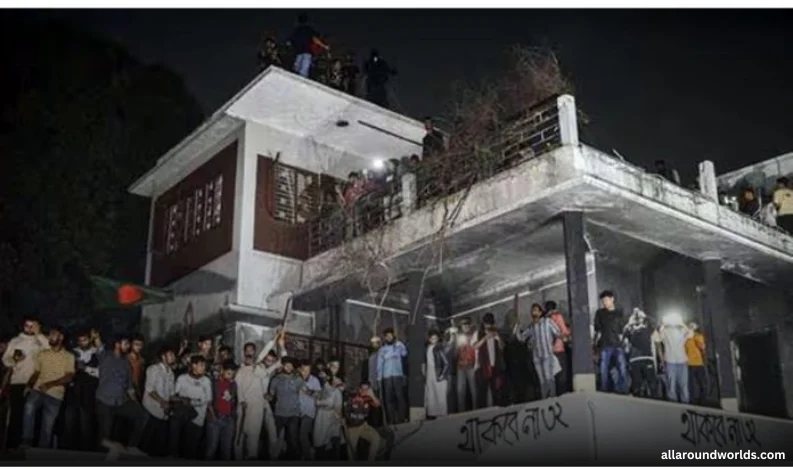
Mujibur Rahman’s Vandalized Home: A Symbol of Resistance, A Witness to History
Dhaka, Bangladesh – Tucked away in an upscale neighborhood of Dhaka, the historic Dhanmondi-32 residence, once home to Sheikh Mujibur Rahman, the founder of Bangladesh, has long been a silent witness to some of the nation's most defining moments. However, on February 5, 2025, this iconic house was vandalized by a mob, following a social media call for a ‘bulldozer procession’ amid political unrest.
The attack on the house came shortly after Sheikh Hasina, Mujibur Rahman’s daughter and Bangladesh’s ousted Prime Minister, delivered a speech urging resistance against the current government. Hasina, who has been in India since her removal from power in August 2024, was visibly emotional as she condemned the attack in an audio address.
"A structure can be erased, but history cannot be wiped out," she said, reflecting on the deep significance of her family home.
India Condemns the Attack on an Iconic Landmark
India, which has shared historical ties with the Dhanmondi-32 house, condemned the act as "regrettable." The Indian External Affairs Ministry emphasized that the house is a "symbol of heroic resistance" for the people of Bangladesh.
"Those who value the freedom struggle that shaped Bangladeshi identity recognize the importance of this residence in the national consciousness of Bangladesh," stated the Ministry.
The 1971 Indian Army Rescue: A Historic Operation
Dhanmondi-32’s historical importance is not just as Mujibur Rahman’s residence but as the site of an extraordinary Indian Army rescue mission during the Bangladesh Liberation War of 1971.
As Bangladesh gained independence on December 16, 1971, following the surrender of Pakistan’s Lt. Gen. A.A.K. Niazi to India’s Lt. Gen. Jagjit Singh Aurora, Rahman’s family was still held hostage at Dhanmondi-32. Unaware that Pakistan had already surrendered, Pakistani troops stationed at the residence remained prepared to execute the captives at any sign of defeat.
The following morning, Indian forces were alerted to the situation. A four-member Indian squad, led by Major Ashok Tara, was tasked with rescuing the hostages. However, the mission was fraught with danger—Pakistani troops had orders to kill the captives in case of an imminent defeat.
Major Ashok Tara’s Brave Stand
As the rescue squad reached the house, Major Ashok Tara made a bold decision—he ordered his men to stand back and approached the heavily armed Pakistani guards alone and unarmed.
"Another step and we will shoot you," the Pakistani soldiers warned.
Remaining calm, Tara reasoned with them in Hindi and Punjabi, explaining that Pakistan had already surrendered and that he was standing before them unarmed as proof. The guards, initially skeptical, eventually agreed to release the hostages after Tara assured them of their safety.
As a result, Rahman’s wife, Sheikh Hasina, and two of her siblings were rescued, marking a significant moment in Bangladesh’s liberation struggle.
Decades later, in 2012, Sheikh Hasina, then Bangladesh’s Prime Minister, honored Major Ashok Tara with the ‘Friend of Bangladesh’ award for his bravery.
The 1975 Massacre: A Dark Chapter
Four years after Bangladesh’s independence, Dhanmondi-32 was once again at the center of a tragic event.
On the night of August 15, 1975, a group of Bangladeshi army personnel stormed the residence and brutally assassinated Sheikh Mujibur Rahman along with 18 members of his family. This shocking massacre plunged Bangladesh into political turmoil, paving the way for a military-led government under General Ziaur Rahman.
Sheikh Hasina’s Survival and Return
At the time of the massacre, Sheikh Hasina and her sister, Sheikh Rehana, were in Europe, sparing them from the brutal attack. Upon returning to South Asia, India granted Hasina and her family asylum in Delhi, where they lived in secrecy for years.
Hasina later described her life in exile as that of a "secret resident" in Delhi.
When she returned to Bangladesh in 1981, she took a personal initiative to save the Dhanmondi-32 house from being auctioned. Eventually, the property was entrusted to the Bangabandhu Memorial Trust, which later converted it into the Bangabandhu Sheikh Mujibur Rahman Memorial Museum—a landmark dedicated to preserving Bangladesh’s tumultuous history.
The Attack on Dhanmondi-32: A New Challenge to Bangladesh’s History
The recent vandalism of Dhanmondi-32 comes at a time when Bangladesh is navigating intense political instability. The attack on such a historic and symbolic landmark has reignited political tensions, with supporters of Sheikh Hasina condemning the destruction and government authorities defending their stance.
As the legacy of Sheikh Mujibur Rahman continues to shape Bangladesh’s political landscape, the preservation of Dhanmondi-32 remains a crucial issue—one that holds deep historical, cultural, and emotional significance for millions of Bangladeshis.
Conclusion: A House That Stands for History
Dhanmondi-32 is more than just a building—it is a testament to Bangladesh’s resilience, freedom struggle, and sacrifices. It has seen acts of heroism, tragedies, and political upheavals, and its preservation remains a key part of safeguarding Bangladesh’s national memory.
With history as its witness, the fate of Dhanmondi-32 will continue to influence Bangladesh’s evolving political and social narrative for years to come.



Recent Comments:
No comments yet.